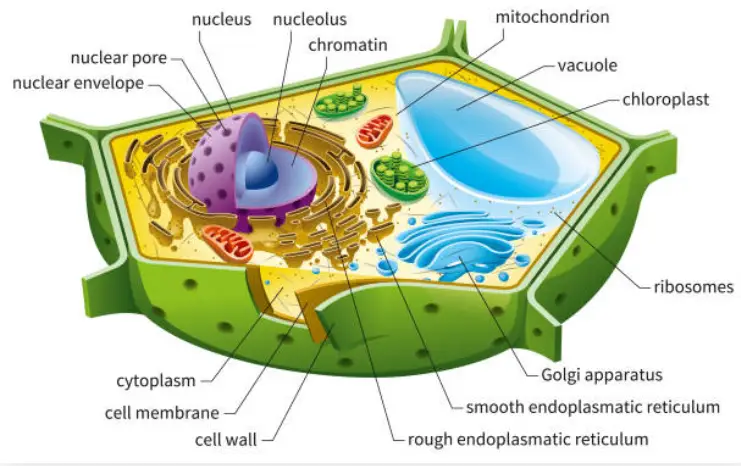The dynamic of cell structure, organization of the plant cell
Introduction
- The cell is the fundamental unit of life, the building block from which all organisms are constructed. The properties of cells exhibiting the characteristics of life define both the potential capabilities and inherent limitations of all living organisms.
- The cell theory, given in 1839 by German biologists M. Schleiden and Theodor Schwann, was originally based on the observation that different kinds of cells resemble one another microscopically and functionally.
- When the properties of various cell types were examined, it was found that cells share common functional characteristics carried out by specialized subcellular structures known as organelles.
Structure and Organization of the Plant Cell
Introduction The plant cell is a fundamental unit of life, serving as the building block for all plant organisms. It is unique in its structure and function, exhibiting specialized components that enable it to perform essential life processes such as photosynthesis, nutrient transport, and cellular communication. The plant cell’s organization is defined by its intricate network of organelles, membranes, and supportive structures, each playing a vital role in sustaining life.

Plant Cell Wall and Plasma Membrane The plant cell is enclosed by two essential layers: the plasma membrane and the cell wall.
- Plasma Membrane – A selectively permeable structure that controls the exchange of substances between the cell and its surroundings. It consists of a phospholipid bilayer embedded with proteins that facilitate communication and transport.
- Cell Wall – A rigid protective layer found outside the plasma membrane, composed mainly of cellulose, hemicellulose, and pectin. It provides mechanical support, prevents excessive water uptake, and maintains cell shape. The secondary cell wall, found in some plant cells, contains lignin, making it more rigid and impermeable.
- Plasmodesmata – Small cytoplasmic channels in the cell wall that allow direct communication and exchange of molecules between adjacent plant cells.
Cytoplasm and Organelles The cytoplasm is the fluid-like substance within the plasma membrane, containing various organelles responsible for maintaining cellular function. The major organelles include:
- Nucleus
- Stores genetic material (DNA) and regulates cellular activities.
- Surrounded by a double-membrane nuclear envelope with pores for exchange of materials.
- Contains chromatin fibers, which condense into chromosomes during cell division.
- The nucleolus, located inside the nucleus, is responsible for ribosome synthesis.
- Endoplasmic Reticulum (ER)
- A network of interconnected membranes forming tubules and sacs.
- Rough ER – Studded with ribosomes, involved in protein synthesis and transport.
- Smooth ER – Lacks ribosomes, involved in lipid synthesis and detoxification.
- Golgi Apparatus
- Stacks of flattened membranous sacs involved in processing, packaging, and transporting proteins and lipids.
- Modifies proteins received from the ER and packages them into vesicles for secretion or internal use.
- Mitochondria
- The powerhouse of the cell, responsible for cellular respiration and ATP production.
- Contains a double membrane with an inner folded structure called cristae, increasing the surface area for energy production.
- Contains its own DNA and ribosomes, allowing it to replicate independently.
- Chloroplasts
- Found only in plant cells, responsible for photosynthesis.
- Contains chlorophyll, a pigment that captures sunlight energy to convert it into chemical energy.
- Has a double membrane and an internal system of thylakoid membranes stacked into grana.
- Like mitochondria, chloroplasts contain their own DNA and ribosomes.
- Vacuoles
- Large, fluid-filled vesicles that store water, nutrients, waste products, and defensive compounds.
- Maintain cell turgor pressure, which is essential for plant rigidity and structure.
- Also involved in cellular detoxification and recycling of macromolecules.
- Lysosomes and Peroxisomes
- Lysosomes contain hydrolytic enzymes for digesting cellular waste and foreign substances.
- Peroxisomes break down fatty acids and detoxify harmful substances such as hydrogen peroxide.
Cytoskeleton and Intracellular Transport The cytoskeleton provides structural support and facilitates intracellular transport. It consists of three main components:
- Microtubules – Hollow protein tubes made of tubulin, essential for cell division, intracellular transport, and maintaining cell shape.
- Actin Filaments (Microfilaments) – Composed of actin, involved in cytoplasmic streaming, cell motility, and shape maintenance.
- Intermediate Filaments – Provide structural support and anchoring of organelles, though less understood in plant cells.
Tissue Organization in Plants Plant cells are grouped into different tissue systems based on their function and location:
- Dermal Tissue System
- Forms the outer protective layer of the plant.
- Includes the epidermis, which is covered by a waxy cuticle to reduce water loss.
- Some epidermal cells develop specialized structures like stomata for gas exchange.
- Ground Tissue System
- Comprises the bulk of the plant body, involved in storage, photosynthesis, and support.
- Includes parenchyma, collenchyma, and sclerenchyma cells with varying degrees of flexibility and strength.
- Vascular Tissue System
- Specialized for transporting water, minerals, and nutrients.
- Includes xylem, responsible for water and mineral transport, and phloem, which distributes organic nutrients.
Multiple-Choice Questions (MCQs)
- What is the primary function of the plant cell wall?
a) Transport nutrients
b) Provide structural support
c) Synthesize proteins
d) Store genetic material - The plasma membrane is primarily composed of:
a) Cellulose and lignin
b) Phospholipid bilayer and proteins
c) RNA and proteins
d) Glucose and amino acids - Which of the following organelles is responsible for photosynthesis?
a) Mitochondria
b) Ribosomes
c) Chloroplast
d) Nucleus - What is the function of the plasmodesmata?
a) Protein synthesis
b) Cellular respiration
c) Cell-to-cell communication
d) Lipid metabolism - The nucleus is enclosed by:
a) A single membrane
b) A double membrane
c) A protein coat
d) A cellulose wall - Which organelle is known as the “powerhouse of the cell”?
a) Ribosomes
b) Golgi apparatus
c) Mitochondria
d) Endoplasmic reticulum - What is the main component of the primary plant cell wall?
a) Chitin
b) Cellulose
c) Phospholipids
d) Protein - The large central vacuole in plant cells is mainly responsible for:
a) DNA replication
b) Photosynthesis
c) Storing water and nutrients
d) Producing ribosomes - Which type of endoplasmic reticulum is involved in protein synthesis?
a) Smooth ER
b) Rough ER
c) Golgi apparatus
d) Vacuole - The stack of membranes in the Golgi apparatus is called:
a) Thylakoids
b) Cristae
c) Cisternae
d) Microtubules - What pigment is responsible for absorbing light in plant cells?
a) Hemoglobin
b) Chlorophyll
c) Carotene
d) Melanin - The function of lysosomes in plant cells is to:
a) Store starch
b) Digest waste materials
c) Transport water
d) Produce energy - What organelle packages and modifies proteins for transport?
a) Endoplasmic reticulum
b) Golgi apparatus
c) Ribosome
d) Lysosome - The secondary cell wall is rich in:
a) Lignin
b) Protein
c) RNA
d) Phospholipids - Which part of the chloroplast contains chlorophyll?
a) Cristae
b) Thylakoid membrane
c) Matrix
d) Stroma - The primary function of ribosomes is:
a) Lipid synthesis
b) Energy production
c) Protein synthesis
d) DNA replication - The cytoskeleton is made up of:
a) Microtubules, actin filaments, and intermediate filaments
b) Only microtubules
c) Only actin filaments
d) DNA and RNA - The cell’s genetic material is stored in the:
a) Mitochondria
b) Ribosomes
c) Nucleus
d) Cytoplasm - Which organelle contains its own DNA?
a) Golgi apparatus
b) Ribosomes
c) Mitochondria
d) Vacuole - The smooth ER is involved in:
a) Protein synthesis
b) Lipid synthesis
c) ATP production
d) DNA replication - The gel-like substance inside the cell is called:
a) Cytoplasm
b) Nucleoplasm
c) Plasma membrane
d) Stroma - Which of the following is NOT found in a plant cell?
a) Cell wall
b) Chloroplast
c) Centrioles
d) Large central vacuole - Xylem is responsible for transporting:
a) Sugars
b) Water and minerals
c) Proteins
d) Lipids - The phloem transports:
a) Water
b) Sugars and nutrients
c) Oxygen
d) Enzymes - Which component of the cytoskeleton helps in cell division?
a) Microtubules
b) Intermediate filaments
c) Microfilaments
d) Golgi vesicles - The process of energy production in mitochondria is called:
a) Photosynthesis
b) Glycolysis
c) Cellular respiration
d) Fermentation - In which part of the chloroplast does the light-dependent reaction occur?
a) Stroma
b) Thylakoid membrane
c) Outer membrane
d) Cristae - The nuclear pores allow:
a) Passage of light
b) Movement of DNA
c) Exchange of materials between the nucleus and cytoplasm
d) Transport of glucose - The nucleolus is involved in:
a) DNA replication
b) ATP production
c) Ribosome synthesis
d) Lipid transport - Which organelle plays a role in detoxification?
a) Lysosome
b) Smooth ER
c) Golgi apparatus
d) Peroxisome - The outermost layer of the plant cell is:
a) Plasma membrane
b) Cytoplasm
c) Cell wall
d) Nuclear membrane - Which cytoskeletal component is responsible for intracellular transport?
a) Microtubules
b) Actin filaments
c) Intermediate filaments
d) Golgi vesicles - The function of peroxisomes is to:
a) Produce proteins
b) Break down fatty acids and hydrogen peroxide
c) Store starch
d) Transport lipids - The thylakoid membrane contains:
a) DNA
b) Enzymes
c) Chlorophyll
d) Ribosomes - The stroma is the:
a) Fluid in mitochondria
b) Fluid in chloroplasts
c) Storage area in vacuoles
d) Space between nuclear membranes - Which plant tissue is responsible for photosynthesis?
a) Xylem
b) Phloem
c) Ground tissue
d) Epidermis - The function of the Golgi apparatus is:
a) Protein synthesis
b) Packaging and transport of proteins
c) Energy production
d) DNA storage - The mitotic spindle is composed of:
a) Ribosomes
b) Golgi vesicles
c) Microtubules
d) Actin filaments - What is the function of pits in plant cells?
a) Gas exchange
b) Cell division
c) Transport of water between cells
d) Protein synthesis - The major function of the intermediate filaments is:
a) Cell motility
b) Structural support
c) Photosynthesis
d) Protein transport
Answer Key
b) Provide structural support
b) Phospholipid bilayer and proteins
c) Chloroplast
c) Cell-to-cell communication
b) A double membrane
c) Mitochondria
b) Cellulose
c) Storing water and nutrients
b) Rough ER
c) Cisternae
b) Chlorophyll
b) Digest waste materials
b) Golgi apparatus
a) Lignin
b) Thylakoid membrane
c) Protein synthesis
a) Microtubules, actin filaments, and intermediate filaments
c) Nucleus
c) Mitochondria
b) Lipid synthesis
a) Cytoplasm
c) Centrioles
b) Water and minerals
b) Sugars and nutrients
a) Microtubules
c) Cellular respiration
b) Thylakoid membrane
c) Exchange of materials between the nucleus and cytoplasm
c) Ribosome synthesis
b) Smooth ER
c) Cell wall
a) Microtubules
b) Break down fatty acids and hydrogen peroxide
c) Chlorophyll
b) Fluid in chloroplasts
c) Ground tissue
b) Packaging and transport of proteins
c) Microtubules
c) Transport of water between cells
b) Structural support
